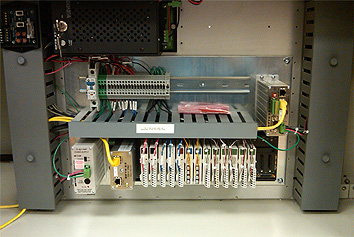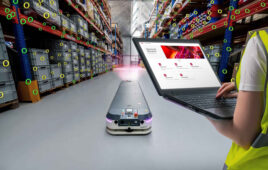Advanced Energy is a manufacturer of gas and liquid flow management systems, thermal instruments, and other power systems and components such as its Radiant Technology Corporation (RTC) furnace which can reach temperatures of more than 850°C. It is used to fire components before they are integrated into larger systems and machines. Ensuring that the furnace operates at the correct thermal profile is critical and any malfunctions or imprecision can compromise components.
The furnace had been operating perfectly since the mid-1990s. It included an Opto22 G4LC32 controller remotely communicating to distributed I/O. The aging Windows 95-based PC, however, which was connected through ARCnet and was hosting the system’s human machine interface, suffered a catastrophic system failure. The company remedied the situation by rebuilding the PC, but a new problem surfaced. In the years since the furnace had first been designed and built, Opto22 developed a new generation of faster and more powerful controllers, I/O, and software.

The furnace upgrade began with the removal of the old I/O processor to be replaced with an Opto 22 SNAP-PAC-EB1 brain. It serves as an intelligent communications and I/O processor capable of multiple functions.
Advanced Energy engineers knew they could realize improvements in performance and gain other advantages by moving to this new hardware. They contracted with Malisko Engineering to help them upgrade the furnace controls by designing a system based on the new hardware and software.
The upgrade began with the removal of the old I/O processor to be replaced with Opto 22’s SNAP-PAC-EB1 brain. It serves as an intelligent communications and I/O processor capable of functions such as latching, counting, pulsing, and event/reactions. The EB1 can also perform thermocouple linearization and PID control, two functions that are essential in many heating-related processes.
“We reconfigured temperature-zone PID control for the furnace in a way that used the built-in PID capabilities of the new SNAP brain,” said Daniel Malyszko, senior system engineer, Maliska. “The old control hardware executed PID control-about four loops per rack-through custom commands. Also, there was more limited space on the I/O rack, so handling all the inputs and outputs needed for PID was an issue. With the new system, however, PID control can be programmed more easily and the EB1 can handle up to 96 loops simultaneously.”
I/O included analog output modules to control the speed and intensity of current and voltage powering the furnace, digital output modules to switch that power, and thermocouple modules that accept temperature input from the furnace’s type K thermocouples.
Malyszko was able to integrate the existing wiring from all the furnace’s internal devices and thermocouples into a new modular I/O backplane. By using existing field devices and wiring this way, the upgrade was completed quickly and furnace downtime was minimal. The I/O backplane built by Malisko Engineering also included the EB1 brain, which communicated back to a new controller, a SNAP-PAC-S1.

Advanced Energy worked with Malisko Engineering to help them upgrade the furnace controls by designing a system based on the new hardware and software.
The SNAP-PAC-S1 controller was programmed with PAC Project, which retains the same look and feel as the old software while supporting the more powerful features of the S1. Programming the system was a challenge because many of the furnace processes relied on numerous custom commands that were developed using the Forth programming language. These external commands could not be imported into PAC Project, which meant they had to be reverse-engineered and reproduced. Malyszko was able to recover the external command library and replicate its function with equivalent commands he programmed in OptoScript code-a programming tool, similar to scripting languages such as Visual Basic, C, and C++, that can be used to augment Opto22’s standard flowchart-based programming when there is a need for control functions involving “if-then-else” processes, complex math, or string handling.
Advanced Energy’s HMI also required an upgrade. OptoDisplay (part of the old software suite) communicated to a PC, providing recipe management and process visualization. This HMI was upgraded to PAC Display, which communicates over Ethernet to any networked PC.
Malisko Engineering simulated the new furnace control system offsite. After successfully testing the recipes, the new system was demonstrated on site before formal startup and commissioning. The project took approximately six weeks including system build and programming. The installation, including running thermal profiles, took two days.
Discuss this on the Engineering Exchange:
Malisko Engineering
www.malisko.com
Advanced Energy
www.advanced-energy.com
Opto22
www.opto22.com
::Design World::
Filed Under: Factory automation, CONNECTIVITY • fieldbuses • networks, PLCs + PACs





Tell Us What You Think!